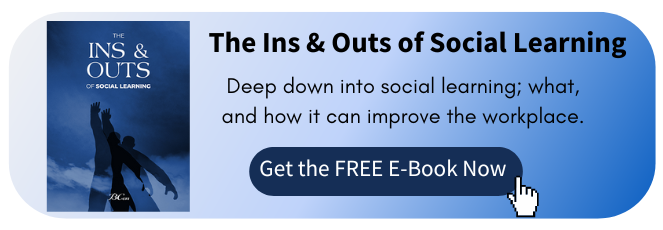Socializing in the Workplace
"People frequently learn solutions to issues that have already been resolved. Collaboration solves problems that no one has ever solved before."
- Marcia Conner
The remark by Marcia Conner above emphasizes the value of social learning through collaboration, which can aid problem-solving. This is also accurate in terms of the workplace. Companies can enhance training programs with little additional expense by integrating social learning capabilities into their learning and development initiatives.
Social Learning is less expensive and more interesting than conventional learning methods like instructor-led instruction, and it has a rapid return on investment (ROI).
The following outstanding data demonstrate the ROI and influence of social learning theory as it relates to the Workplace.
- The maker of ceramics Villeroy & Boch, reports that the average transaction value in Japan increased by 32% due to their social learning method.
- Tiendas Aurgi, the Spain-based automobile repair chain, reveals that social learning increased their overall floor productivity by 30%.
- In its first year of using social learning in the transition to a global services firm, Cisco's rate of employee acceptance was 98%.
- AMD, a semiconductor manufacturer, claims that switching to social learning has allowed them to reduce their annual online training costs by more than $250,000.
Ideas for Implementing Social Learning in the Workplace
Social Learning can be utilized in businesses in a variety of ways. Social learning methods may speed up learning if they are seamlessly incorporated into daily activities. People who learn well in social settings may find great relief in social learning, which has extra advantages for businesses wishing to implement this learning approach within their organizations.
Several options need different levels of effort to integrate social learning into corporate learning.
Learning Groups
Creating "Learning Groups" is the most obvious strategy, as frequently is the case with in-person lectures. There are several people in the same room learning new information. It is possible to learn more efficiently through social interaction and observation, because:
- Group activities promote direct communication
- Individual questions help participants understand each other better
- Everyone present learns more when someone defends their point of view, and instructors can utilize focused questioning to guide learners toward developing their own understanding and drawing connections
The majority of children's educational systems still start with this traditional example of social learning.
Benchmarking
In many ways, human behavior is predictable. This knowledge can favourably impact the promotion of learning. It is in everyone's instinct to desire to judge themselves against others who act as the benchmark, outperform them, or simply stay up.
You can share your learning progress with others using tools like internal networking and gamification with the correct learning technology.
The internal competition that benchmarking fosters motivates other workers to learn new abilities to participate, rank higher than others, or keep up with the advancement of their coworkers. To prevent learning motivation from deteriorating into competitiveness and envy, it is critical to keep the meaning and rewards of results within realistic limits.
Setting the Bar High
Setting the bar high internally can be done by setting an example. It is not unusual for superiors to perform a specific role as role models in addition to delegating work and exercising leadership. Many staff members aspire to get to this, or a related, job one day, so they naturally observe their superior's conduct. Social Learning at this point occurs pretty naturally. Employees are more likely to try to analyze and, if feasible, mimic the behavior of a superior who is more positive, likeable, and well-liked.
It is typically seen when managers and people in authority do something. Supervisors should therefore take advantage of the available learning opportunities and be transparent about doing so to inspire employees to learn. People always imitate successful people, especially those in their close surroundings. To put this concept into practice, if a manager learns for a half-hour each day, the staff will also learn more about adaptability and success-oriented behavior.
1 Grove, Thao Nguyen Le, Social learning theory in the workplace for beginners, Accessed 3 Dec 2022, https://blog.grovehr.com/social-learning-theory-in-the-workplace
For more about this topic, download our latest book " The Ins & Outs of Social Learning" for FREE:
